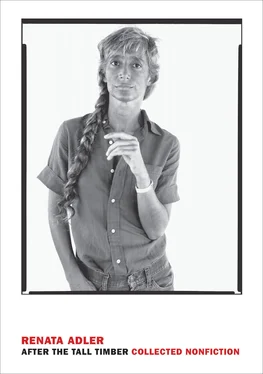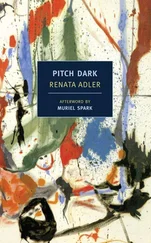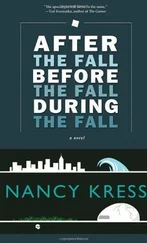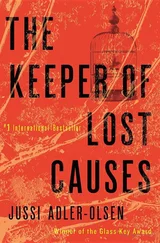The doctrine of preemption, in international affairs, amounts to a variant of injunction in drastic military form. The questions — whether the preempting nation will otherwise suffer irreparable injury; whether that injury outweighs whatever damage preemption itself might cause; and whether the preemption will not be adverse to the public interest — are much the same. There has, of course, been nothing inherently violent in the ancient equitable remedy of injunction. And a real injunction can issue only from a court, or other neutral tribunal. (In at least two cases now before the Supreme Court, the administration actually argues that the president, the military, even Intelligence “Interrogators” are, under recent law, just such “neutral” tribunals, which can be trusted like any other court; the cases reached the Court at about the same time photographs of the work of Interrogators came out of Abu Ghraib.)
In his dissent in Morrison , in 1988, Justice Scalia wrote, with some bitterness, of “the wisdom of our former constitutional system.” In Bush v. Gore , decided four years ago, the balance of powers which sustains that system was radically undermined. Now, under vastly more critical circumstances, there is another national election. Whatever the outcome, and whether or not any court will intervene, the fusion of all powers in a single prosecutorial power, of unprecedented scope and almost limitless discretion, is sure to test the Court again. Whether we are already speaking of our “former constitutional system” will depend in great part on what that Court decides.
2004
THE PORCH OVERLOOKS NO SUCH THING
“THERE’S no complacency here. Never has been. Never will be.” (Arthur Sulzberger, Jr., publisher of The New York Times , July 14, 2003.) This is, in its way, a classic utterance. For one thing it begins with a perfect example of the self-refuting sentence. In its underlying idiocy and limitless self-regard it also manages to embody, and project through time, a virtual definition of the word “complacency.” Sulzberger had assembled the Times staff to announce the appointment of a new executive editor, Bill Keller, a popular choice. The staff, however, was preoccupied with something else. Howell Raines, Keller’s predecessor, had appeared on The Charlie Rose Show a few nights before, and expressed several views critical of the paper. He had described the Times as “an irreplaceable national institution.” He had even said (somewhat more debatably) that “the great advantage” the Times has “over any other news organization in the world” is “brain power.” Raines had claimed, however, that the Times had become a “culture of lethargy and complacency.”
Well. It is hard to know what members of the Times staff can have expected from a former boss whom they had savagely attacked in every conceivable forum — from a “town meeting” in which he had to listen to insults both personal and professional and even to abase himself with the sort of confession reminiscent of a Maoist party cell (with the added ignominy of having a toy moose placed in his lap) through a campaign of venomous emails, posted all over the Internet. Maureen Dowd was partly right in comparing this spectacle to Lord of the Flies —with this difference: the Times , in recent years, has lost any awareness of the relation between the one and the many, of the real moral questions raised by piling on and ganging up. The behavior of those assembled was characteristic in some ways of an institution whose chief principle of action has become increasingly this: it will not permit itself to be criticized, contradicted or even questioned, in public. The Lord of the Flies aspect, the fact that the critic in this case was a former boss, whom it had very recently humiliated and deposed, was incidental. As the Times ’s powers have grown (through the attrition of other newspapers), its sense of the vulnerability of the individual in the face of those institutional powers has vanished. In fact, it feels victimized.
At the same time, its one inviolable belief has become simply this, not a politics, right or left, but an ideology: the Times , as an institution, believes what has been published in its pages. To defend this belief it will go very far. The search, the grail, the motivating principle for individual reporters has become, not the uninflected reporting of news, but something by now almost entirely unrelated: the winning of a Pulitzer Prize. In the interim, some other prize will do. But once won, the Pulitzer turns into both a shield and a weapon — a shield in defense of otherwise indefensible pieces by Pulitzer Prize winning reporters, a weapon in the struggle for advancement within the hierarchy of the Times . The paper still has some very fine editors and reporters, with highly honorable concerns. But a five-year moratorium on the awarding of Pulitzer Prizes to journalists at powerful publications might be the greatest service to journalism the Pulitzer Committee could now perform.
In any event, Howell Raines had said on The Charlie Rose Show that the Times was complacent. Sulzberger’s words were intended — and perhaps somewhere perceived — as a rebuttal to this remark. In recent years, executive editors of the Times have tended to find the paper much improved during their tenure. At a retreat in Tarrytown, New York, in September 2000, Joseph Lelyveld had expressed to eighty newsroom editors, and a few colleagues from other publications, his belief that the Times had become “the best New York Times ever — the best written, most consistent, and ambitious newspaper Times readers have ever had.” In July, in the course of the infamous Charlie Rose Show , Howell Raines said, “The newspapers that we have produced over the past twenty months are the best in the history of the Times .”
Whether or not these were expressions of complacency, they would have been unthinkable for the predecessors of these men — for the executive editors, Turner Catledge, say, or A.M. Rosenthal, who said he only wanted to be remembered as the editor who “kept the paper straight.” Rosenthal did keep the paper straight, in a time that now seems unimaginably remote — with a first-rate staff and the discreet support of the Times ’s publisher in those years, Sulzberger’s father. In any event, the current Sulzberger’s words on the subject of complacency, or non-complacency, marked the culmination of what has become the saga of The New York Times and Jayson Blair.
The saga began on April 26, 2003, when the Times published a piece which a 27-year-old staff reporter, Jayson Blair, had essentially cribbed from an article published eight days earlier in the San Antonio Express-News . The original article had been written by Macarena Hernandez, a former intern (and colleague of Blair’s) at the Times ; it consisted mainly of an interview with Juanita Anguiano, the single mother of an only son, Specialist Edward J. Anguiano, of Los Fresnos, Texas, the last American soldier still missing at that time in Iraq. Normally, as Jayson Blair had every reason to know, calling attention to errors in the Times , provided that they are absolutely trivial (misspellings of first or last names, mistaken middle initials, misidentifications of who is standing on the left and who on the right in photographs), may result in a Correction. Calling attention to major or substantial errors will have no result at all. The Times , committed to an image of infallibility on every important factual matter, will neither acknowledge them nor respond in any way.
Читать дальше






![Джеффри Арчер - The Short, the Long and the Tall [С иллюстрациями]](/books/388600/dzheffri-archer-the-short-the-long-and-the-tall-s-thumb.webp)





